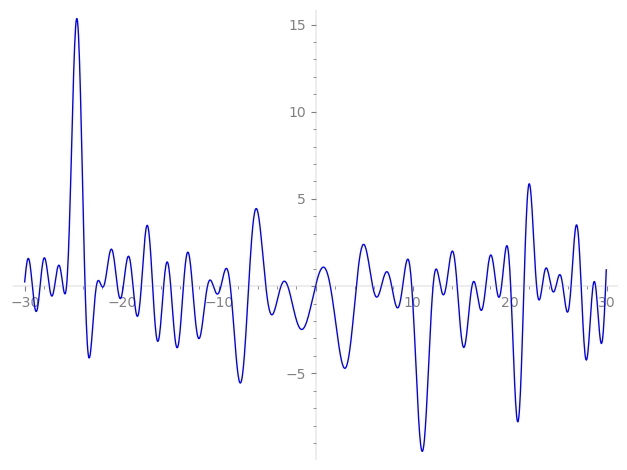| L(s) = 1 | + (−0.834 − 5.59i)2-s + 19.2i·3-s + (−30.6 + 9.34i)4-s + 60.1i·5-s + (107. − 16.0i)6-s − 153.·7-s + (77.8 + 163. i)8-s − 126.·9-s + (336. − 50.2i)10-s − 121i·11-s + (−179. − 587. i)12-s − 633. i·13-s + (128. + 859. i)14-s − 1.15e3·15-s + (849. − 571. i)16-s − 512.·17-s + ⋯ |
| L(s) = 1 | + (−0.147 − 0.989i)2-s + 1.23i·3-s + (−0.956 + 0.291i)4-s + 1.07i·5-s + (1.21 − 0.181i)6-s − 1.18·7-s + (0.429 + 0.902i)8-s − 0.518·9-s + (1.06 − 0.158i)10-s − 0.301i·11-s + (−0.359 − 1.17i)12-s − 1.04i·13-s + (0.174 + 1.17i)14-s − 1.32·15-s + (0.829 − 0.558i)16-s − 0.429·17-s + ⋯ |
\[\begin{aligned}\Lambda(s)=\mathstrut & 88 ^{s/2} \, \Gamma_{\C}(s) \, L(s)\cr =\mathstrut & (-0.902 + 0.429i)\, \overline{\Lambda}(6-s) \end{aligned}\]
\[\begin{aligned}\Lambda(s)=\mathstrut & 88 ^{s/2} \, \Gamma_{\C}(s+5/2) \, L(s)\cr =\mathstrut & (-0.902 + 0.429i)\, \overline{\Lambda}(1-s) \end{aligned}\]
Particular Values
| \(L(3)\) |
\(\approx\) |
\(0.0118859 - 0.0526109i\) |
| \(L(\frac12)\) |
\(\approx\) |
\(0.0118859 - 0.0526109i\) |
| \(L(\frac{7}{2})\) |
|
not available |
| \(L(1)\) |
|
not available |
\(L(s) = \displaystyle \prod_{p} F_p(p^{-s})^{-1} \)
| $p$ | $F_p(T)$ |
|---|
| bad | 2 | \( 1 + (0.834 + 5.59i)T \) |
| 11 | \( 1 + 121iT \) |
| good | 3 | \( 1 - 19.2iT - 243T^{2} \) |
| 5 | \( 1 - 60.1iT - 3.12e3T^{2} \) |
| 7 | \( 1 + 153.T + 1.68e4T^{2} \) |
| 13 | \( 1 + 633. iT - 3.71e5T^{2} \) |
| 17 | \( 1 + 512.T + 1.41e6T^{2} \) |
| 19 | \( 1 + 2.60e3iT - 2.47e6T^{2} \) |
| 23 | \( 1 + 311.T + 6.43e6T^{2} \) |
| 29 | \( 1 - 4.36e3iT - 2.05e7T^{2} \) |
| 31 | \( 1 + 5.37e3T + 2.86e7T^{2} \) |
| 37 | \( 1 - 7.94e3iT - 6.93e7T^{2} \) |
| 41 | \( 1 + 1.04e4T + 1.15e8T^{2} \) |
| 43 | \( 1 + 1.90e4iT - 1.47e8T^{2} \) |
| 47 | \( 1 + 2.43e3T + 2.29e8T^{2} \) |
| 53 | \( 1 + 5.24e3iT - 4.18e8T^{2} \) |
| 59 | \( 1 + 1.49e4iT - 7.14e8T^{2} \) |
| 61 | \( 1 + 8.56e3iT - 8.44e8T^{2} \) |
| 67 | \( 1 + 2.80e4iT - 1.35e9T^{2} \) |
| 71 | \( 1 + 5.66e4T + 1.80e9T^{2} \) |
| 73 | \( 1 - 6.05e4T + 2.07e9T^{2} \) |
| 79 | \( 1 + 8.63e4T + 3.07e9T^{2} \) |
| 83 | \( 1 - 1.17e5iT - 3.93e9T^{2} \) |
| 89 | \( 1 - 6.26e4T + 5.58e9T^{2} \) |
| 97 | \( 1 + 8.86e4T + 8.58e9T^{2} \) |
| show more | |
| show less | |
\(L(s) = \displaystyle\prod_p \ \prod_{j=1}^{2} (1 - \alpha_{j,p}\, p^{-s})^{-1}\)
Imaginary part of the first few zeros on the critical line
−12.70542488406460359561890560945, −11.15730709412937797280578849241, −10.55309941308101818637284745851, −9.768521104187178114486045872029, −8.805709332647297774045417823719, −6.91341925814565719057087139300, −5.14441397074735986644036429145, −3.57657170857441939078043008381, −2.88426893535587891463163619077, −0.02384401255548975232441420132,
1.50350363898585083773508776246, 4.18718658761686510303781882262, 5.86641966778168179803087000837, 6.76686042564703960260801502982, 7.83028145825550511976853235382, 8.962529207150427212119452868356, 9.896757087724853871823141801260, 12.09659354558678210343362032281, 12.85733832583988608292746805508, 13.44711192608863429123115211248

